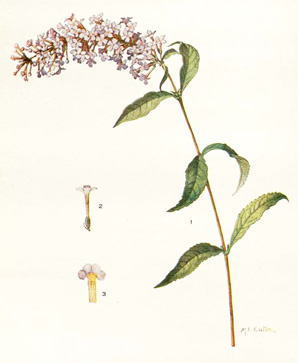The Butterflies' Bush
By Audrey Stallsmith

Anyone who has sun and the scrappiest amount of soil can grow a butterfly bush.
Jo Kellum, Southern Sun
I thought I was clever to plant the dwarf Buddleja ‘Buzz Midnight’ in a pot with Heliotropium ‘Marine’ and Supertunia ‘Violet Star Charm’ this year. Although the combination of purples was attractive, I now have to ask myself whether the butterfly bush will survive in such a container over the winter, with the answer being “probably not!”
Since conditions have been dry lately, I’ll have to wait until we get a good rain to plant it in the ground instead. It was attractive, with dark panicles of flowers against silvery foliage. So I can recommend the cultivar, just not my method of growing it.
Most butterfly bushes originated in China, though some also are native to Africa, southern Asia and the Americas. Back around 1730, a Scottish ship’s surgeon named Dr. William Houstoun sent one type from the Caribbean to England. My sources disagree over whether that was americana or globosa, but I’m guessing the former is more likely.
Houston asked that the plant be named for the late British minister and botanist, Adam Buddle. Linnaeus obliged, though—to this day—the genus name may be spelled either as Buddleja or Buddleia. Houstoun died of heatstroke at age 38, so he didn’t get time to do much more plant prospecting himself.
Buddleja globosa, with its orange globes of blooms, made it to England from South America by 1774. It is mentioned in an 1878 edition of The Garden as an attractive companion for rock rose. The better-known type of butterfly bush, with lilac-like spikes of flowers, apparently didn’t become popular until the introduction of the hardiest species--davidii--from China in the late 1800s.
Named for missionary botanist Armand David, it actually was discovered by another missionary, Jean Andre Soulie, who was martyred in 1905 at age 48. The butterfly bush seems to have been a bad luck plant for its short-lived discoverers. But David, though prone to frequent severe illnesses, toughed them out until his 74th year.
Butterfly bush is somewhat controversial these days, due to its invasiveness in the Pacific northwest and other milder zones. Here in our northeastern zone 5, even davidii--like the man for whom it was named--barely survives. So we can plant it to our heart’s content with no danger of it taking over.
Although its flowers’ honey-sweet nectar is highly attractive to butterflies, some naturalists complain that the bush provides only nectar and isn’t a plant on which butterfly larvae can feed. Since there are plenty of other host plants here, I don’t worry about that overly much.
Sometimes known as summer lilac because it, too, makes panicles of four-lobed flowers, butterfly bush generally is considered a shrub. However, it dies back to the ground every winter here in zone 5, like a herbaceous plant, and sprouts fairly late in the spring. So you may begin to suspect that it has kicked the bucket before it finally appears.
A dark purple type of davidii survived the longest for me. I also was able to grow Buddleja x weyeriana 'Honeycomb,' which only is supposed to be hardy to zone 7, by positioning it in a protected position between an apple tree and large rose bush. It survived there for several years before dying out.
The flowers of Buddleja officinalis have been used in China to treat eye diseases and to color rice. But the butterfly bush generally is grown for the beauty of its flowers--or for the flying flowers which flock to it.
Their ephemeral existence causes me to reflect on the sometimes short lives of the missionaries and/or plant explorers who died in the process of bringing good news and great beauty into the lives of others. I have to conclude that they probably accomplished more with their few years than most of us do with many.
The Buddleia davidii image is by M. E. Eaton from Addisonia, Volume II, courtesy of plantillustrations.org.








